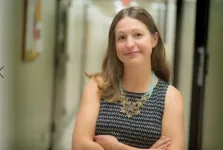(Press-News.org) Instead of looking at the reasons child welfare caseworkers leave their jobs, Oregon State University researchers examined the common factors among workers who stay in the field, and what makes them feel most satisfied in their work.
In their recent study, researchers found that quality supervisory support and strong relationships with coworkers helped caseworkers feel appreciated and understood, while having adequate technology and equipment helped them manage their workload effectively
They hope child welfare agencies can use this information to support caseworkers and reduce the field's high turnover and burnout rates, which in turn will mean better support for children and families.
"Caseworkers have very challenging jobs, but some are satisfied with the work despite its challenges, and they intend to stay," said co-author Kelly Chandler, an assistant professor in OSU's College of Public Health and Human Sciences. "If we want to improve continuity in terms of service to children and families in the community, it's important to not only minimize the job challenges that are inevitable, but also think about which employees are really thriving and what we can learn from them."
Researchers sent a confidential online survey to all social service specialist caseworkers in Oregon's Department of Human Services in 2018 and were able to use the data from 485 respondents, including 222 from Child Protective Services.
The survey posed a series of statements and asked caseworkers to rank how strongly they agreed with them. The statements covered a range of topics, from job satisfaction and intention to remain, to more specific items about job resources, such as: "My supervisor gives me clear feedback on my job performance" and "I have the technology and equipment to do my job well."
For more quantitative points about job demands, researchers examined objective agency records to measure caseload and case severity. They took a unique approach to measure case severity, basing it on the number of substantiated abuse flags in a single client family, up to a total of five per family.
Case severity was the only job demand shown to have a significant negative impact on whether an employee was a "satisfied stayer;" that is, someone who intended to stay at the agency and was satisfied in their job. They compared satisfied stayers with undecided workers and found caseworkers were 8% less likely to be in the satisfied stayer group if they had severe caseloads.
On the flip side, all three job resources studied -- supervisor quality, coworker support and work tools -- were significantly and positively associated with caseworkers feeling satisfied and wanting to stay in their jobs.
Lead author Brianne Kothari, an assistant professor at OSU-Cascades, said that while there are obvious budget and salary factors that affect caseworker retention, this study demonstrates that agencies also need to remember the value of intangible support for their workers.
"It's really about finding how we can support caseworkers to increase their job satisfaction and intention to stay at ODHS," Kothari said. "They want to feel seen and heard. It might be a pat on the back for one person; it might be something else for another person. This study demonstrates the importance of quality supervisor relationships and the need to identify specific supervisory behaviors that benefit employees. It's also important to remember that all workers, including supervisors, need support."
That kind of emotional support, both from coworkers who are "in the trenches" together, and from supervisors who see how hard caseworkers are working, can go a long way toward helping employees feel that they're not alone, Chandler said.
This study aligns with a broader effort at Oregon DHS to transform the workplace culture and employ more trauma-informed approaches to training at all levels, Kothari said. And it opens the door for further collaboration between OSU and the agency, where researchers can work together to dig into the data and help the agency solidify the best evidence-based practices.
"This is part of our effort to figure out how we can better collaborate with state agencies, which I think really falls within the OSU land grant mission," Kothari said. With ODHS, "There are ways we can think about how we as a larger community can be supportive of these workers, who are really there because they want to make a difference in these children's and families' lives."
INFORMATION:
BIRMINGHAM, Ala. - Clinical evaluation of three COVID-19 vaccine candidates in 2020-21 during a worldwide pandemic that killed or sickened millions was unprecedented in terms of urgency and scope. Responsibility for the safety, integrity and scientific validity of the trials in the United States fell to 12 experts of the federally appointed COVID-19 Vaccine Data and Safety Monitoring Board, or COVID-19 DSMB, who in turn report to an oversight group.
This COVID-19 DSMB team -- which included co-contributing author Richard Whitley, M.D., distinguished professor of pediatrics in the University of Alabama ...
For the first time, researchers have used precariously-balanced rocks to set the formal design earthquake motions for a major existing engineered structure--the Clyde Dam, the largest concrete dam in New Zealand.
Mark Stirling of the University of Otago and colleagues identified and assessed the ages of these gravity-defying rock formations located about 2 kilometers from the dam site, using these data to determine the peak ground accelerations that the rocks could withstand before toppling.
This in turn was used to set the Safety Evaluation Earthquake (SEE) spectrum for the dam, or ...
An underwater archaeologist from The University of Texas at Arlington is part of a research team studying 9,000-year-old stone tool artifacts discovered in Lake Huron that originated from an obsidian quarry more than 2,000 miles away in central Oregon.
The obsidian flakes from the underwater archaeological site represent the oldest and farthest east confirmed specimens of western obsidian ever found in the continental United States.
"In this case, these tiny obsidian artifacts reveal social connections across North America 9,000 years ago," said Ashley Lemke, assistant professor of sociology and anthropology at UT Arlington. "The artifacts found below the Great Lakes come from a geological source in Oregon, 4,000 kilometers away---making it one of the longest distances ...
"So, no one told you life was going to be this way.
Your job's a joke, you're broke, you're love life's DOA.
It's like you're always stuck in second gear,
When it hasn't been your day, your week, your month, or even your year..."
If you have watched TV since the 1990s, the sitcom theme song, "I'll Be There for You," has likely been stuck in your head at one point or another. New research from UC Davis suggests these experiences are more than a passing nuisance -- they play an important role in helping memories form, not only for the song, but also related life events like hanging out with friends ...
When a fictional female journalist appears on screen, chances are she's about to sleep with one of her sources. It's a trope that infuriates actual women in news media -- and it can have real-life consequences, says University of Florida researcher Frank Waddell, Ph.D.
In shows like "House of Cards" and movies like "Thank You for Smoking," female reporters are quick to trade sex for information. Even when sex with sources has nothing to do with ambition -- such as the hookups in "Sharp Objects," "Top Five," "Trainwreck," and the "Gilmore Girls" reboot, to name a few -- it still portrays unethical behavior.
"In the past 20 to 30 years, Hollywood has really latched on to this. ...
A study of media coverage of 623 scientific papers on Alzheimer disease research conducted in mice reveals that the news media are more likely to write a story about alleged breakthroughs or medical research findings if research authors omit mice from their studies' titles. On the other hand, papers that acknowledge mice in their titles result in limited media coverage.
In addition, the study titled "What's not in the news headlines or titles of Alzheimer disease articles? #In mice" conducted by Dr Marcia Triunfol of Humane Society International and Dr Fabio Gouveia of the Oswaldo Cruz Foundation in Brazil, and published in PLoS ...
Discussions of a broken value system are ubiquitous in science, especially after the COVID-19 pandemic served to expose inequality globally. However, according to the authors of an article publishing 15th June 2021 in the open access journal PLOS Biology, science itself is not "broken," but it was built on deeply-entrenched, systemic sexist and racist values, which perpetuate biases through the continued focus on citation rates and impact factors.
The author maintain that while equity within science has advanced thanks to the tireless efforts of generations of systemically marginalized groups, the system remains outdated, colonialist, and patriarchal. ...
Financial toxicity, the financial strain experienced by patients accessing health care, impacts a large population of cancer patients according to prior research. A new study, published in JACC: CardioOncology, finds financial toxicity is often greater among heart disease patients compared to cancer patients, and those with both conditions suffer the highest burden.
"Heart disease and cancer are the leading causes of death in the United States, yet most research on financial toxicity has focused on cancer patients. It is important to consider that cancer patients may have short bursts of high expenditures for treatments, while heart disease patients are often incurring ...
The number of people dying from cardiovascular disease (CVD) in Asia is increasing rapidly, with over half of all CVD deaths globally in 2019 occurring in Asian countries, according to a state-of-the-art review paper published in the inaugural issue of JACC: Asia. The data demonstrates an urgent need to understand the burdens and epidemiological features of CVD in Asian countries to develop localized CVD prevention strategies to combat the epidemic.
From 1990 to 2019, the number of CVD deaths in Asia rose from 5.6 million to 10.8 million. Nearly 39% of these CVD deaths were premature, meaning they occurred in a person less than 70 years old, which was significantly higher than premature CVD deaths in the U.S. (23%). Most ...
There is increasing scrutiny around how science is communicated to the public, but what is the relationship between how scientists report their findings and how media reports it to the public? A study published in PLOS Biology by Marcia Triunfol at Humane Society International, in Washington, DC and Fabio Gouveia at Oswaldo Cruz Foundation in Rio de Janeiro, Brazil suggests that when authors of scientific papers omit the basic fact that a study was conducted in mice (and not in humans) from the article title, journalists reporting on the paper tend to do the same.
Alzheimer's Disease is an exclusively ...



